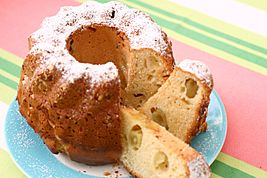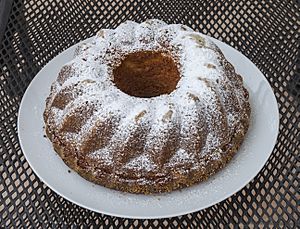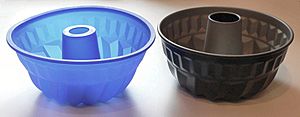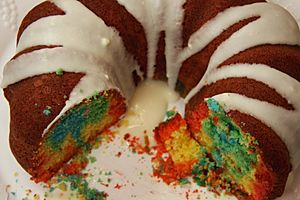Bundt cake facts for kids

A partially sliced Bundt cake
|
|
| Type | Cake |
|---|---|
| Course | Dessert |
| Place of origin | United States |
| Region or state | Minneapolis |
| Created by | H. David Dalquist |
| Main ingredients | Flour, sugar, eggs |
A Bundt cake is a special kind of cake baked in a Bundt pan. This pan gives the cake its unique doughnut-like shape with a hole in the middle. The idea for this shape comes from a traditional European cake called Gugelhupf. However, Bundt cakes themselves don't have one specific recipe.
The Bundt pan became very popular in North America in the 1950s and 1960s. This happened after a company called Nordic Ware trademarked the name "Bundt" and started making these pans from aluminum. Later, the Pillsbury food company helped make Bundt cakes even more famous.
Contents
Where the Name Comes From

The name "Bundt cake" partly comes from a European cake called Gugelhupf. This cake is similar to a brioche bread. In parts of Germany, Gugelhupf is also known as Bundkuchen. This name combines two German words: Bund and Kuchen (which means cake).
People have different ideas about what the word Bund means here. One idea is that it means "bunch" or "bundle." This could refer to how the cake dough is wrapped around the center tube of the pan. Another idea is that it describes the banded look the cake gets from the pan's fluted (grooved) sides. This look is a bit like a tied bundle of wheat. Some people also think Bund might mean a "group of people." If so, Bundkuchen would be a cake perfect for parties and get-togethers.
The word bund was used outside Europe to describe cakes around the early 1900s. You can find it in old Jewish-American cookbooks. Sometimes, it was even spelled "bundte" in recipes.
How Bundt Pans Are Designed
Bundt cakes are special because of their shape, not because of a specific recipe. A Bundt pan usually has wavy or grooved sides. It's also often coated to make it easy to remove the cake after baking.
Like other pans with a central tube or hole, the Bundt pan helps cakes bake better. The hole in the middle allows heat to spread faster and more evenly. This is very helpful when baking large amounts of batter.
Ring-shaped pans, like Bundt molds, heat up quicker than regular round pans. They also bake thick cakes evenly, even if they are larger than 9 inches across. For very deep or large cakes, heating cores are often suggested to make sure the heat spreads well.
Since "Bundt" is a trademark name, other similar pans are sold under different names. You might see them called "fluted tube pans." The company that owns the trademark, Nordic Ware, makes Bundt pans only from aluminum. However, you can find similar fluted pans made from other materials.
Even though they look similar, a Gugelhupf is different from modern Bundt-style cakes. A Gugelhupf uses a specific yeast-based recipe, often with fruit and nuts. It's also usually deeper and more decorated. Other cakes made with yeast, like babka or monkey bread, can also be baked in Bundt molds. Today, Bundt pans are used for many types of cakes, including those made from boxed mixes. They can even be used to mold gelatin salads, ice cream, or savory dishes like meatloaf.
How Bundt Cakes Became Popular
Two American businessmen, H. David Dalquist and his brother Mark S. Dalquist, helped make the Bundt cake famous. They started a cookware company called Nordic Ware in St. Louis Park, Minnesota.
In the late 1940s, two friends named Rose Joshua and Fannie Schanfield asked Dalquist for help. They were part of a Jewish-American group called the Hadassah Society. They wanted a modern version of a traditional cast iron Gugelhupf pan. Dalquist and his engineer, Don Nygren, designed a new pan made from cast aluminum. Nordic Ware made a small number of these pans in 1950. To make sure they could trademark the name, they added a "t" to "Bund," creating "Bundt." Some of these original Bundt pans are now kept in the Smithsonian museum collection.
At first, the Bundt pan didn't sell well, and Nordic Ware thought about stopping its production. But things changed! The pan was mentioned in the New Good Housekeeping Cookbook in 1963. Its real popularity began in 1966. That year, a Bundt cake called the "Tunnel of Fudge," baked by Ella Helfrich, won second place at the yearly Pillsbury Bake-Off contest. She won $5,000!
This win brought a lot of attention to the Bundt pan. Pillsbury received over 200,000 requests for Bundt pans. Soon, the Bundt pan became the best-selling pan in the United States, even more popular than the old Jell-O molds. In the 1970s, Pillsbury even got permission from Nordic Ware to use the "Bundt" name and sold their own Bundt cake mixes.
So far, Nordic Ware has sold more than 60 million Bundt pans across North America. November 15 has even been named "National Bundt Day"!
See also
 In Spanish: Bizcocho bundt para niños
In Spanish: Bizcocho bundt para niños
Images for kids






